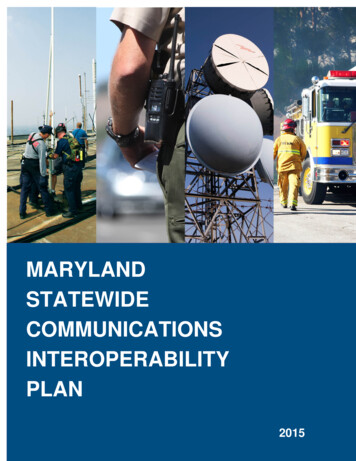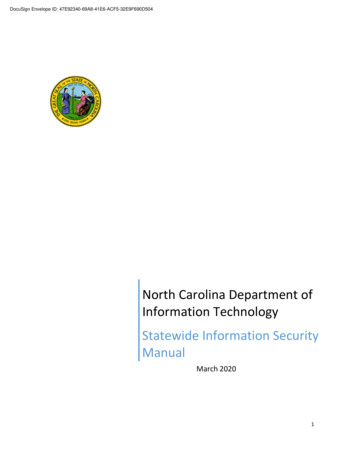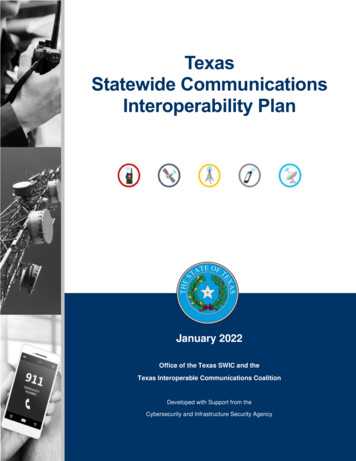
Transcription
AN2015
EXECUTIVE SUMMARYThe Maryland Statewide Communications Interoperability Plan (SCIP) is a stakeholderdriven, multi-jurisdictional, and multi-disciplinary statewide strategic plan to enhanceinteroperable and emergency communications. The SCIP is a critical mid-range (threeto five years) strategic planning tool to help Maryland prioritize resources, strengthengovernance, identify future investments, and address interoperability gaps. It should beconsidered a living document and is updated annually. For the purposes of this plan,interoperable communications includes but is not limited to traditional land mobile radiosystems, broadband based systems, next generation 911, data interoperability, videointeroperability, applications, systems and other forms of public safety communications.The purpose of Maryland’s SCIP is: To provide the strategic direction and alignment within Maryland’s ecosystem forthose responsible for interoperable, emergency communications at the State,regional, local, and Federal levels.To provide information for governmental leadership and elected officials on thevision for interoperable, emergency communications and demonstrate the needfor funding.To recognize the unique geography of the State in which almost all countiesborder different states and/or the District of Columbia and tailor procedures toaddress the importance of interstate cooperation1 and work with intrastate andinterstate jurisdictions, as well as appropriate federal users, to promoteinteroperability.The following are Maryland’s Vision and Mission for improving emergencycommunications operability, interoperability, and continuity of communicationsstatewide.Vision: Continue the development and implementation of statewide and local systemsthat will support communications interoperability and will facilitate real-timecommunications and data sharing across agencies, jurisdictions, levels of government,and ultimately, across State boundaries. Interoperable communications will ensure thatMaryland’s public safety providers can coordinate with one another, share information,and provide a coordinated response to any event or emergency.Mission: Maryland has developed and implemented a series of technical solutions thatprovide secure, coordinated, real-time voice, video and data communications able tospan jurisdictional and organizational boundaries. The aim of these efforts is to:1Only Anne Arundel, Calvert, Howard, and Talbot counties do not border another state and/or the Districtof Columbia. Allegany, Cecil, Frederick, Garrett, Montgomery, Prince George’s, Washington, andWorcester counties border multiple states and/or the District of Columbia.MARYLAND STATEWIDE COMMUNICATION INTEROPERABILTY PLANDRAFT 20152
Facilitate central command and control of State and local governmentcommunications as required to support multiple emergencies and coordinate thedeployment of emergency services from federal, state, out-of-state, and localresources. Augment local government communications resources in major population areasthrough the implementation of a statewide public safety communications systemthat provides redundancy for local government communications systems. Serve as an interoperable communications infrastructure linking federal, State,and local government communications, when needed, for public safety agenciesas well as governmental and non-governmental resources supporting disasterrelief. Provide unique statewide and regional wide-area interoperable communicationscapabilities when necessary to meet extraordinary emergencies affecting multiplelocal jurisdictions.The following strategic goals represent the priorities for delivering Maryland’s vision forinteroperable emergency communications. Governance –o Strengthen existing local, regional, and interstate partnerships andconsider including additional stakeholders as applicable (e.g., IT, CIOs,critical infrastructure, non-governmental agencies, and federal agencies).o Work with the Radio Control Board and local governments to ensureMaryland FiRST is able to continue deployment, complement/integrateregional radio communication networks, and provide operational supportand maintenance.o Establish subcommittees of SIEC to focus on technological issues,outreach, users, coverage, business models, policies and operations.o Participate in FirstNet meetings and federal-state-local contact events toprovide comprehensive input as to Maryland’s first responderrequirements and desired levels of operations; e.g. FirstNet coverage,capacity, governance, prioritization of service, etc.o Work with regional and local consortiums, federal agencies such asCMARC, ESCA, WAGIN, OEC, DHS, FEMA and the National CapitalRegion to ensure a cohesive plan, avoid duplication of efforts and ensureeffective coordination. Standard Operating Procedures (SOPs) –MARYLAND STATEWIDE COMMUNICATION INTEROPERABILTY PLANDRAFT 20153
o Establish and maintain a continuous statewide process that tpracticesrecommendations and keeps them contemporary.o Coordinate with the National Capital Region to ensure cohesiveoperations with first responders not only in Maryland but also from theDistrict of Columbia and the Commonwealth of Virginia.o Address the unique territorial geography challenges of Allegany,Frederick, Garrett, Washington, and Worcester Counties, each of which isbordered by multiple states, to develop SOPs that recognize the naturalinterdependence upon out-of-state resources.o Establish extraordinary communications command and control protocolsfor events involving multi-jurisdiction and interstate first responderresources. Technology and Training –o Coordinate and assist in the development, implementation andsustainment of emergency communications technology across the State toinclude funding support.o Develop and identify practical exercises with federal-state-local partnersthat realistically test interoperable communications at State-local, Stateregional and interstate levels.o Work with the Department of Homeland Security, Technical AssistanceProgram to continue emergency interoperability communications trainingcourses in Maryland. Usage –o Encourage local, State, and interstate support of interoperable publicsafetycommunicationssystemsandtechnology.o Enhance exiting capabilities and identify new opportunities to sharecommunications-related emergency information in real time.o Work to implement the Nationwide Public Safety Broadband Network(NPSBN), also known as FirstNet, for all Maryland First RespondersEmergency Management, and appropriate non-governmental organizationpartners.MARYLAND STATEWIDE COMMUNICATION INTEROPERABILTY PLANDRAFT 20154
o Plan for nationwide interoperability communications stations in areaswhere multiple jurisdictions and/or states can access coverage2.o Conduct operational tests and exercising of relevant technologies toensure that first responders can utilize systems effectively during periodsof an emergency or extraordinary event. Outreach and Continued Operations –o Organize outreach efforts and familiarization/publicity materials in supportof interoperable systems and technology in the State of Maryland.o Identify and provide access to critical radio channels across agency andcounty lines in partnership with local jurisdictions and other mutual aidpartners.o Work with State, federal, and local law enforcement, fire and emergencymedical services, allied public safety organizations, the Departments ofBudget and Management, State Police, Information Technology, theGovernor’s Office, and the General Assembly to ensure that interoperablecommunications systems and technology in the State continues to receivefunding for deployment as well as operational support and maintenance.27TAC54 at Lamb’s Knoll, as an example, can support first responders in Frederick and Washingtoncounties in Maryland as well as users in the adjoining counties in Pennsylvania and Virginia. The focus ofother new stations might be the Delaware-Maryland border where there is extensive interoperability.MARYLAND STATEWIDE COMMUNICATION INTEROPERABILTY PLANDRAFT 20155
TABLE OF CONTENTSEXECUTIVE SUMMARY . 21. INTRODUCTION . 82. PURPOSE . 133. VISION AND MISSION . 144. GOVERNANCE. 155. STANDARD OPERATING PROCEDURES (SOPS) . 176. TECHNOLOGY . 186.1 Computer-Aided Dispatch / Records Management System/Automatic VehicleLocated/Mobile CAD (CAD/RMS/AVL/Mobile).186.2 Automated Crash Reporting System (ACRS) .196.3 Electronic Traffic Information Exchange (E-TIX) .196.4 Regional Automated Property Information Database (RAPID) .206.6 MView and 700 MHz Radio – Maryland FiRST .216.7 Nationwide 700 and 800 MHz Interoperability Channels .236.7.1 – 700 MHz nationwide interoperability channels . 236.7.2 – 800 MHz nationwide interoperability channels . 236.7.3 – TAC Stack – VHF/UHF/800 MHz nationwide interoperability channels . Error!Bookmark not defined.6.8700 MHz Air-Ground Communications .246.9Regional Interoperability Operations .256.106.9.1Central Maryland Area Radio Communications Network (“CMARC”) . 256.9.2Eastern Shore Communications Alliance (“ESCA”) . 256.9.3National Capital Region (Washington Metropolitan Council of Governments . 266.9.4Southern Maryland . 266.9.5Washington-Allegany-Garrett Interoperability Network (“WAGIN”) . 27Interstate Communications Interoperability .286.10.1Interoperability with the State of Delaware State Police . 286.10.2Interoperability with the District of Columbia Metropolitan Police . 286.10.3Interoperability with the Pennsylvania State Police . 296.10.4Interoperability with the Virginia State Police. 296.10.5Interoperability with the West Virginia State Police . 306.10.6Washington Metropolitan Area Transit Administration . 31MARYLAND STATEWIDE COMMUNICATION INTEROPERABILTY PLANDRAFT 20156
6.10.7Regional Interservices Channels (“RINS”) . 316.10.8Fire Mutual Aid Radio System (FMARS) . 326.10.9Police Mutual Aid Radio System (PMARS) . 326.10.10Low Power 700 MHz Channels . 336.11Interoperability with Federal law enforcement and emergency officials .336.12Deployable 700 MHz Interoperable Trunking Radio Systems .346.13Continuing Technical Challenges to Interoperability .356.14Communications Security .366.14.1Encryption. 366.14.2Radio Authentication. 376.14.3Radio Authentication. 376.15Inter-RF Sub-system Interface (“ISSI”) .386.16OSPREY .397. TRAINING AND EXERCISES . 408. USAGE AND OUTREACH . 419. LIFE CYCLE FUNDING . 4310. STRATEGIC PLAN REVIEW . 4511. REFERENCE DOCUMENTS . 46APPENDIX A: LIST OF ACRONYMS. 47MARYLAND STATEWIDE COMMUNICATION INTEROPERABILTY PLANDRAFT 20157
1. INTRODUCTIONThe Maryland Statewide Communication Interoperability Plan (SCIP) is a stakeholderdriven, multi-jurisdictional, and multi-disciplinary statewide strategic plan to improvepublic safety voice, data, video communications by implementing standards-based,interoperable communications technologies. The SCIP is a critical mid-range (three tofive years) strategic planning tool to help Maryland prioritize resources, strengthengovernance, identify future investments, and address interoperability gaps. It should beconsidered a living document that is updated annually. This document contains thefollowing planning components: Introduction – Provides the context necessary to understand what the SCIP isand how it was developed. Purpose – Explains the purpose/function(s) of the SCIP in Maryland. Scope – Identifies the governmental and non-governmental entities for which theSCIP is written. Vision and Mission – Articulates the State’s three- to five-year vision and missionfor improving emergency communications operations, interoperability, andcontinuity of communications at all levels of government. Governance and SOPs – Outlines the governance structure and the operatingprocedures developed, or in development, in support of statewidecommunications interoperability. Technology – Describes the statewide and other interoperable communicationssystems currently in use across the State Usage and Funding – Explains how usage of the various systems is bothmeasured and encouraged, and how systems are funded to provide continueduse by law enforcement and public safety teams statewide. Reference Documents – Includes documents that provide additional backgroundinformation on the SCIP or interoperable and emergency communications inMaryland or directly support the SCIP.Figure 1 on the following page provides additional information about how thesecomponents of the SCIP interrelate to develop a comprehensive plan for improvinginteroperable and emergency communications.MARYLAND STATEWIDE COMMUNICATION INTEROPERABILTY PLANDRAFT 20158
Figure 1: SCIP Strategic Plan and Implementation ComponentsThe Maryland SCIP is based on an understanding of the current and mid-rangeinteroperable and emergency communications environment or ecosystem. Marylandhas taken significant steps towards improving and expanding interoperable emergencycommunications, including: Creating strong interstate, intrastate, and regional coordination at all levels ofgovernment.Garnering executive support of emergency communications technologiesDevelopment, deployment and support of new statewide systems such as thestatewide Computer-Aided Dispatch and Records Management System(CAD/RMS), the Automated Crash Reporting System (ACRS), Electronic TrafficInformation Exchange (E-TIX), and the Regional Automated Property InformationDatabase (RAPID), Delta Plus, MView and Osprey.Planning, development, and deployment of Maryland’s new statewide 700 MHzRadio systemIt is important to note that these efforts are part of a continuous cycle, as Maryland willalways need to adapt to emerging technologies, operational changes, and changes tokey stakeholder initiatives. In the next three to five years, Maryland will encounterMARYLAND STATEWIDE COMMUNICATION INTEROPERABILTY PLANDRAFT 20159
challenges relating to interoperability, geography, aging equipment/systems, emergingtechnologies, ongoing support and maintenance, and sustainable funding.Wireless voice and data technology is evolving rapidly and efforts are underway todetermine how to leverage these new technologies to meet the needs of public safety.For example, the enactment of Title VI the Middle Class Tax Relief and Job CreationAct of 2012 authorizes the deployment of the Nationwide Public Safety BroadbandNetwork (NPSBN). The NPSBN is intended to be a wireless, interoperable nationwidecommunications network utilizing twenty megahertz of the 700 MHz frequency band thatwill allow members of the public safety community to securely and reliably gain andshare information with their counterparts in other locations and agencies.Figure 2 below illustrates a public safety communications evolution by describing thelong-term transition toward a desired converged future.Figure 2: Public Safety Communications EvolutionIntegrating capabilities such as MView, CAD to CAD, ACRS, E-TIX, RAPID, OSPRY,AVL, Patient Tracking and broadband radio provide an unparalleled opportunity for thefuture of interoperable communications in Maryland, the region and the Nation. Robustrequirements and innovative business practices must be created for these initiativesprior to nationwide implementation. Maryland public safety organizations havedeveloped partnerships within our region (FEMA Region III) to ensure deployment ofthese technologies in a fully interoperable manner.Additionally, achieving sustainable funding in the current fiscal climate is a priority forMaryland. As Federal grant funding diminishes, states need to identify alternativefunding sources to continue improving interoperable and emergency communicationsfor voice and data systems. Key priorities for sustainable funding are:MARYLAND STATEWIDE COMMUNICATION INTEROPERABILTY PLANDRAFT 201510
o Maryland FiRST, the statewide 700 MHz public safety radio system, which willhave the ability, once completed, to provide interoperable communications on alocal, regional, or statewide basis.o Statewide and regional public safety data systems to improve fire, EMS and lawenforcement response to improve response to man-made and natural emergencyevents.o Regional communications and data systems in high population areas providinginterstate and intrastate public safety interoperable communications.o NPSBN (FirsNet) system once implemented.More information on a typical emergency communications system life cycle, costplanning, and budgeting is available in OEC’s System Life Cycle Planning Guide.3Figure 3: The Interoperability ContinuumThe Interoperability Continuum, developed by SAFECOM and shown in Figure 3,serves as a framework to address all of these challenges and continue improvingoperable/interoperable and emergency communications. It is designed to assistemergency response agencies and policy makers with planning and implementinginteroperability solutions for voice and data communications.The Continuum identifies five critical success elements that must be addressed toachieve a successful interoperable communications solution:3OEC’s System Life Cycle Planning Guide is available here:http://publicsafetytools.info/oec guidance/docs/OEC System Life Cycle Planning Guide Final.pdfMARYLAND STATEWIDE COMMUNICATION INTEROPERABILTY PLANDRAFT 201511
Governance – Collaborative decision-making process that supportsinteroperability efforts to improve communication, coordination, and cooperationacross disciplines as well as jurisdictions within and adjacent to Maryland.Governance is the critical foundation of all of Maryland’s efforts to addresscommunications interoperability. SOPs – Policies, best practices, and procedures that guide emergencyresponder interactions and the use of interoperable communications solutions. Technology – Promote technical standards that permit systems and equipmentthat enable emergency responders to share voice and data informationefficiently, reliably, and securely. Training and Exercises – Scenario-based practices used to enhancecommunications interoperability and familiarize the public safety community withequipment and procedures. Usage – Familiarity with interoperable communications technologies, systems,and operating procedures used by first responders to enhance interoperability.More information on the Interoperability Continuum is available in OEC’s InteroperabilityContinuum brochure4. The following sections will further describe how the SCIP will beused in Maryland and Maryland’s plans to enhance interoperable and emergencycommunications.4OEC’s Interoperability Continuum is available ments/continuum/Default.aspxMARYLAND STATEWIDE COMMUNICATION INTEROPERABILTY PLANDRAFT 201512
2. PURPOSEThe purpose of the Maryland’s SCIP is: To provide the strategic direction, goals and alignment for those responsible forinteroperable and emergency communications at the State, interstate, regionaland local levels.To provide detail to executive leadership and elected officials on the vision forinteroperable emergency communications and demonstrate the need for funding.To identify, refine, and distribute best practices to first responders andrepresentatives of non-governmental organizations supporting disaster relief orwhen responding to incidents.The development and execution of the SCIP assists Maryland with addressing theresults of the NECP Goals, and the Federal government with fulfilling the PresidentialPolicy Directive 8 (PPD-8)5 National Preparedness Goal for OperationalCommunications6 as well as the provisions of the Middle Class Tax Relief and JobCreation Act of 2012 (the Act), specifically Title VI, related to Public SafetyCommunications.Each year Maryland will develop an Annual Progress Report (APR) to the SCIP that willbe shared with OEC and other stakeholders to highlight recent accomplishments anddemonstrate progress toward achieving the goals and initiatives identified in the SCIP.5 PPD-8 was signed in 2011 and is comprised of six elements: a National Preparedness Goal, the National Preparedness System,National Planning Frameworks and Federal Interagency Operational Plan, an annual National Preparedness Report, and ongoingnational efforts to build and sustain preparedness. PPD-8 defines a series of national preparedness elements and emphasizes theneed for the whole community to work together to achieve the National Preparedness Goal. national-preparedness.6National Preparedness Goal – Mitigation and Response Mission Area Capabilities and Preliminary Targets – OperationalCommunications: Ensure the capacity for timely communications in support of security, situational awareness, and operations byany and all means available, among and between affected communities in the impact area and all response forces.1. Ensure the capacity to communicate with both the emergency response community and the affected populations andestablish interoperable voice and data communications between Federal, State, and local first responders.2. Re-establish sufficient communications infrastructure within the affected areas to support ongoing life-sustaining activities,provide basic human needs, and transition to recovery.MARYLAND STATEWIDE COMMUNICATION INTEROPERABILTY PLANDRAFT 201513
3. VISION AND MISSIONThis section describes Maryland’s vision and mission for improving emergencycommunications operability, interoperability, and continuity of communicationsstatewide.Maryland’s Interoperable Emergency Communications Mission:Maryland’s Interoperable Emergency Communications Mission is to facilitate the achievement ofstatewide and regional communications interoperability through applied technology. Tomaximize the State’s communications ecosystem and provide a variety of robust, resilient andreliable interoperable systems for the purpose of maximumizing communications interoperabilityfor all users. To migrate from inter-agency, silo and jurisdictional based technology solutions tostatewide and regional systems that span jurisdictional and organization boundaries.Maryland’s Interoperable Emergency Communications Vision:Deploy statewide and regional systems that will support communications interoperability acrossagencies, jurisdictions, levels of government, and across state boundaries within FEMA RegionIII. Interoperable communications will ensure that Maryland’s public safety providers cancoordinate and communicate with one another, share information, and provide an effective,coordinated response to events or emergencies.MARYLAND STATEWIDE COMMUNICATION INTEROPERABILTY PLANDRAFT 201514
4. GOVERNANCEMaryland has established a governance structure that facilitates the development of astatewide, locally driven interoperability plan that meets the needs of public safety firstresponders.On July 10, 2008, an Executive Order formally establishing Maryland’s StatewideInteroperability Executive Committee (SIEC) was signed. The SIEC is comprised ofsenior elected and appointed officials from State, county, and municipal governmentsappointed by the Governor. The SIEC has the responsibility to provide policy-leveladvice regarding public safety communications interoperability and to promote theefficient and effective use of resources for matters related to public safetycommunications and interoperability.The order also establishes the position of Statewide Interoperability Director (SWID)who is responsible for the Interoperable Communications programs within the State.The Practitioners Steering Committee (PSC) was established to providerecommendations and advice to the SIEC and the Governor’s Office of HomelandSecurity (GOHS) on all matters pertaining to communications interoperability (e.g.,assessment, acquisition, standardization, planning, management, use, and oversight ofcommunications). The PSC is comprised of senior communications practitioners from allfields of public safety. The PSC established the following three permanentsubcommittees that provide the subject matter expertise required to implement publicsafety communications and interoperability projects: 1) Administrative and BudgetarySupport Subcommittee, 2) Technical Subcommittee, and 3) Operations Subcommittee.On April 14, 2014 HB 308/SB 338 was signed creating a joint governance body, calledthe Radio Control Board (RCB), for the Statewide Public Safety Radio System. Thegovernance body includes five representatives of local governments that will use thenew system as well as six state representatives. The RCB will oversee the building,operation, and maintenance of the new Maryland FiRST system.Governance Goals and trengthen regional interand intra-state partnershipsand consider includingadditional stakeholders asapplicable (e.g., publicworks, criticalinfrastructure, privateConduct regular outreach toadditional stakeholders through theregional interoperability committeesand other forms of outreachStateOn goingEstablish a statewide interoperabilityworkshop with representation from allregional interoperability committeesStateAnnuallyMARYLAND STATEWIDE COMMUNICATION INTEROPERABILTY PLANDRAFT 201515
Governance Goals and ector, Maryland StateDepartment of Education,Federal agencies)Strengthen existing governancerelationships with Delaware,Pennsylvania, Virginia, District ofColumbia, West VirginiaState Interoperability andRegional PlanningCommitteesOngoingContinued engagement with /participation in Federalinteroperability initiativesState InteroperabilityCommittees and RegionalPlanning Committees:local representativesOngoingCodify existing governancestructure (existing by wayof executive order) throughlegislationPassed bill creating the Radio Control StateBoard on April 14, 2014CompletedMaryland is also working with the States within FEMA Region III to develop plans for afuture regional deployment of the broadband public safety network and continues tostrengthen partnerships with regional communications on Maryland FiRST and regionalvideo and data systems. The consortium, known as MACINAC, has held severalmeetings with the Region III SWICs to assure interoperability is addressed during theplanning and deployment of this new technology. In conjunction with OEC, Marylandheld a Broadband workshop in March of 2012 to introduce the new Broadband Networkto State and local agencies and to begin planning the State’s approach.Maryland also continues working with other Region II
governance, identify future investments, and address interoperability gaps. It should be considered a living document and is updated annually. For the purposes of this plan, interoperable communications includes but is not limited to traditional land mobile radio systems, broadband based systems, next generation 911, data interoperability, video










